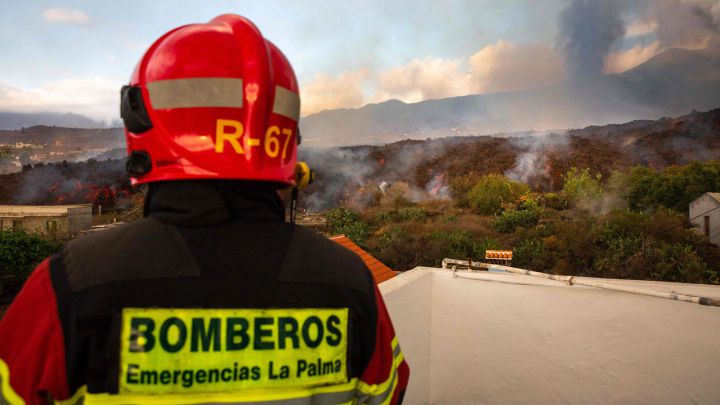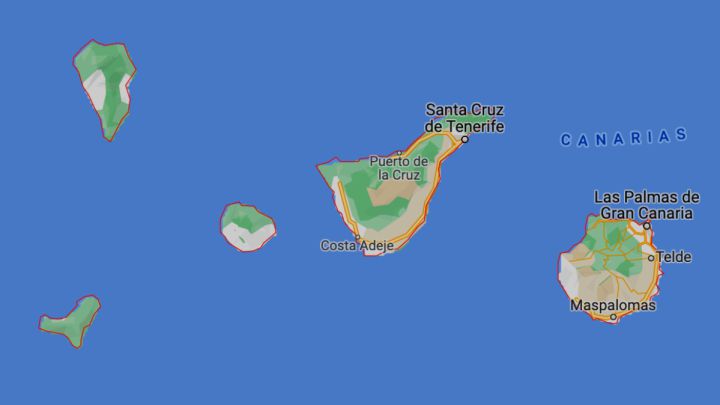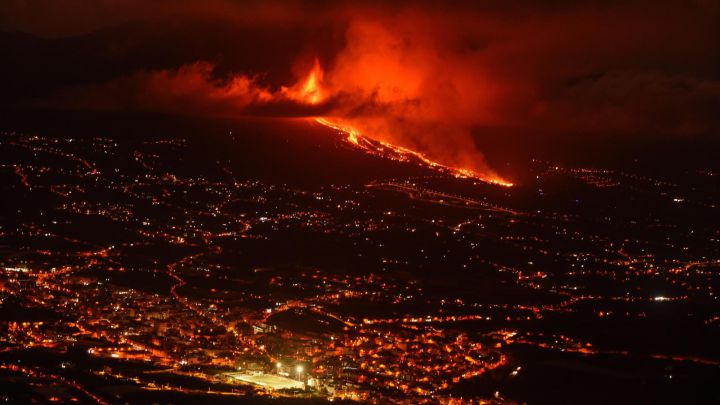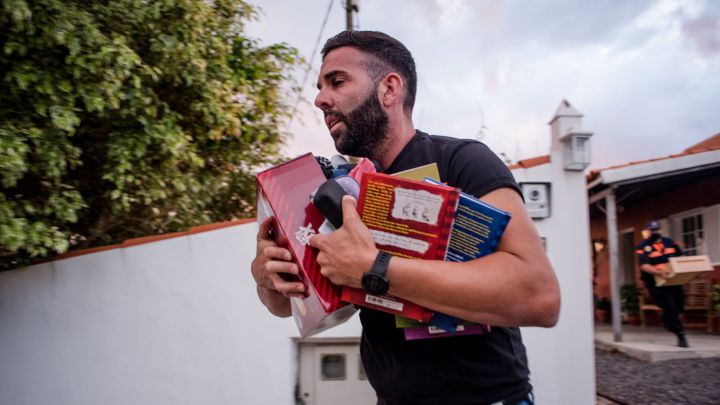La Palma volcano eruption: news summary for 22 September
Lava from the eruption of La Palma's Cumbre Vieja volcano has hit the village of Todoque and is close to reaching the sea. This live blog is now closed.
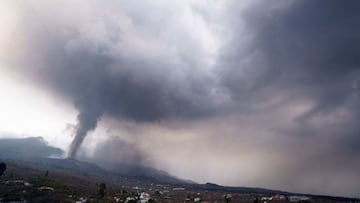
Show key events only
La Palma volcano eruption: live updates
Headlines
- 350 buildings have been destroyed by the lava flow, which now covers 166.2 hectares
- Active volcanoes in the Canary Islands, an overview. (Details)
- When was the last time there was a volcanic eruption in the Canary Islands? (Details)
- The question on the mind of many: What will happen when the lave reaches the ocean? (Details)
Live coverage of La Palma volcano eruption
Here you can see live footage of the volcanic eruption. We have our Spanish team monitoring the situation and will be updating regularly here.
Calls for two restricted air space zones
The Spanish government's Canay Islands Delegation has called for the creation of two restricted air space zones, where only state security forces and emergency services could enter. This will not affect commercial flights to the Canaries as commercial aeroplanes do not fly over the proposed zones.

In pictures: Police officers block a road as lava rises following the eruption of a volcano on the Island of La Palma, in Tacande. (Reuters)
More drone footage of a river lava from the La Palma volcano as it makes its way towards the Atlantic ocean...
Up close look at river of lava approaching Todoque
Emergency crews have been trying to channel the lava flow to save the town of Todoque on La Palma as it pushes constantly forward. Here's a look at what they are up against.
Footage from La Palma eruption
Emergency crews work to help those displaced by the advancing wall of lava which measures over 40 feet (12 m) high in places. The flow of molten rock is advancing at 120 meters per hour.
Lava's slow pace to the ocean means more destruction on land
It's been just over three days since the Cumbre Vieja fissure on La Palma erupted sending molten rock flowing down the mountainside. Initially the flow was moving at about 700 meters (roughly 7 and a half football fields) per hour and was expected to reach the ocean just over 3 miles away by Monday evening.
However the lava at the leading edge has now cooled slowing its advance but forcing the lava to pile up and spill to the side. Around 154 hectares have been covered in lava that has engulfed some 300 structures and crops.
Experts are unsure if the lava will reach the ocean now, with the lava approximately 1.5 miles (2.5 km) from the coast. But as well they don't know how long the molten rock will continue to spew forth.
La Palma volcano: what will happen when the lava reaches the Atlantic Ocean?
As the lava from the La Palma eruption causes destruction as it advances toward the coast, there are worries about new dangers once it arrives to the ocean.
Spanish weather to be affected by sulfur cloud
Winds will be responsible for transporting these next 48 hours the cloud of sulfur dioxide will travel towards the east of Canaries the peninsula, Ceuta, Melilla and the Balearic Islands. In Madrid, it is now due to rain for the next two days, but the level of sulfur is not thought to be dangerous for human health.
Firefighters in bid to save town
Firefighters on La Palma are frantically digging a channel to redirect a river of lava in a last-ditch battle to salvage as much as they can of a town destined to be flattened by molten rock flowing downhill from the Spanish island’s Cumbre Vieja volcano.
Rescue workers on Tuesday night began to use diggers and heavy machinery to create a channel they hope will divert the lava flow, creating the least destructive path possible as it passes through the town of Todoque en route to the sea around one mile away.

What part of the island is the volcano impacting?
Cartographers create 3D map of La Palma island that shows that area impacted by the volcanic eruption. The image was created by Jonni Walker, of Mapbox.
How many active volcanoes are there in the Canary Islands?
How many active volcanoes are there in the Canary Islands?
Like the Hawaiian Islands in the Pacific, the Canary Islands are volcanic in origin.
However, after the eruption on La Palma that has rocked the world, many are wondering if the other islands could face the same fate.
Read more in our full coverage.
How long could the volcanic eruption in La Palma last?
After four days of destruction, the La Palma volcano has ripped through more than 300 structures... and some experts believe this number could increase as lava may not stop flowing for another 84 days.
How many structures have been destroyed in the by the volcanic eruption in La Palma?
Some estimates released by the Spanish government show that the total damage down by the eruption, so far could total as much as $400 million. With no end in sight, this number is expected to increase.
RTN news has reported that more than 320 buildings have been destroyed, and has covered more than 150 hectares of land.

How has the volcano impacted the ph in the waters surrounding the island?
Geologists have been hard at work determining the possible consequences of the volcanic eruption on the ecosystems on the island. Geologists have found that the water surrounding the island, especially the area close to the volcano has seen a nosedive in ph from around seven to four; meaning the water is increasingly acidic.
It is only expected to decrease further when the lava meets the ocean, releasing without a cloud of possibly toxic gases.
Photo: Miguel Calero / EFE
La Palma volcanic eruption leaves behind a trail of destruction
The Irish Times has recently reported on the destruction caused by the volcanic explosion on the island of La Palma. The volcano has been spewing molten lava for four days, and many believe the event could last more than a month. Since the crisis began 80,000 people have been evacuated, and some have lost everything.
For those who have already lost everything, or whose homes or community lie in the path of the lava, the future is unknown.
Lorena, a thirty-year old women who works in a jewelry shop in the town of Los Llanos de Aridane, told the Irish Time, “All we can do is cry. We are a small business, we live off all these people who have lost everything."
Aid will come from the Spanish government and possibly the European Union, but the timeline has not been made clear. What is clear is that people need support now.
Where are the Canary Islands on a map? Who owns the islands?
Last Sunday, the small Canary Island of La Palma became global news following the volcanic eruption on the fifth of the eight islands (size-wise) that compose the Canary Islands archipelago.
The eruption started on Sunday at 10:10 am ET, after a week of seismic tremors, with a huge column of smoke rising above the Cumbre Vieja national park before lava began pouring out of several vents.
Over 5,000 people have been evacuated from the area, and numerous homes, properties and farmland destroyed by lava, which is close to reaching the sea. There are fears of explosions when the lava hits the seawater, as well as the release of more toxic chemicals, and people are being warned to stay away from the area.
Authorities have put in place a nautical exclusion zone around the point where the lava is expected to enter the Atlantic Ocean.
Volcanic eruption in La Palma: What will happen next?
The coordination team monitoring the eruption of a volcano on La Palma, in Spain’s Canary Islands, is working with all possible scenarios, from the starkest to the most benign.
No human loss has been reported, but around 6,000 people have been evacuated and 320 homes destroyed by towering lava flows rising up to 12 meters high. Scientists are also warning about the potential danger of toxic gas clouds if and when the molten rock reaches the sea.
The volcano’s behavior so far, together with the area’s history, suggest that for weeks to come there will continue to be an effusive rather than explosive eruption – that is, when magma flows out of the vent and oozes down the mountainside as lava, without sending rocks, ash or gas high in the air.
A new crater opens in La Palma volcano
A new volcano crater has opened in the La Palma volcano, which has caused the evacuation of the town of Tacando, a neighborhood in the municipality of El Paso. As a result, there are now ten open craters. So far, 5,700 people have had to leave their homes.
Todoque resident describes a “sea of fire”
A resident of Todoque, whose home is among the approximately 200 in the village so far destroyed by the lava flow following the eruption of a La Palma volcano, has told the Spanish news agency EFE that when he sought to save belongings from his house, he encountered “a sea of fire, as if the devil had risen up out of the earth”.
The 1,400 inhabitants of Todoque, located in Los Llanos de Aridane, have been evacuated from the village.
Pretty harrowing footage of a house totally collapsing in La Palma as the lava and molten rock piled up around it....
The velocity of the lava depends on the viscosity and topography
Alicia Felpeto, a volcanologist from Spain's Instituto Geográfico Nacional (IGN), has explained why the lava is now descending so slowly.
"The topography of the land is now flatter, so the lava spreads out in a fan instead of going in a single direction," she said on Spanish TV, speaking to Spanish broadcaster LaSexta.
She added that "practically all the historical lava flows on La Palma have reached the sea" and their predictions on where the lava will flow are "same since the beginning", warning more residents "will be displaced".
Surface area affected by lava flow so far
The total surface area of La Palma affected by the lava flow from the Cumbre Vieja volcano is now estimated to be around 154 hectares.

Officials from the Canary Islands Volcanology Institute (Involcan) take samples from the lava flowing from the Cumbre Vieja volcano.
EFE/Involcan
The race to save belongings
In this video shared by Sputnik Mundo, residents of Todoque can be seen racing to save their belongings before the lava engulfs their homes...
La Palma volcano: what happens when the lava reaches the sea?
Once the lava reaches the water there will be a thermal shock caused by the huge temperature difference between the two materials. It is, after all, lava at around 1,100 degrees Celsius, which is pushing 2,000 degrees Fahrenheit, mixing with the coastal water of 23°C (73°F). This will see a rapid cooling of the hot fluid, with a number of other consequences.

Lava flow so far and expected course
Our colleagues at El País have put together this graphic outlining the lava flow so far and its expected course, having now reached the village of Todoque. The red areas are those most affected by the lava flow.
You'll find more El País graphics (in Spanish) here.
Eruption could last up to 84 days, says Involcan
The eruption of the Cumbre Vieja volcano on La Palma is expected to last between 24 and 84 days, according to calculations by the Canary Islands Volcanology Institute (Involcan).
In a social-media post, Involcan said the duration of an eruption is difficult to estimate precisely, but can be calculated by using data from previous eruptions on La Palma.
The Cumbre Vieja eruption has an average expected duration of 55 days, Involcan said.
The body also says it has detected a “strong increase” in explosive activity in the active vents of the volcano.
Todoque residents allowed to recover possessions until Wednesday evening
The Cabildo de La Palma, the island’s local government, has told the evacuated inhabitants of Todoque that they can return to the village to recover possessions from their homes until 7pm local time on Wednesday.
“Given the slow advance of the lava flow, the plan is to allow citizens from the village of Todoque to access their homes - as long as it's safe - to pick up some belongings or documentation that they might need, and also goods that may be perishable,” the Cabildo said.
The lava flow from the eruption of the Cumbre Vieja volcano reached Todoque on Tuesday, and was estimated earlier on Wednesday to have caused the destruction of around 200 buildings in the town, which has just under 1,500 inhabitants
La Palma volcanic eruption, live updates: welcome
Hello and welcome to our live coverage of the volcanic eruption on the Canary Island of La Palma.
The volcano in the Cumbre Vieja national park began erupting on Sunday, with the flow of lava pouring from its vents causing an estimated 6,000 people to be evacuated from their homes so far.
Copernicus, the European Union’s Earth observation programme, has estimated that around 320 buildings have now been destroyed by the lava flow, which now affects 154 hectares and on Tuesday reached the village of Todoque.
Although the lava flow’s progress has slowed, it continues its march towards the sea, with fears of explosions when it reaches the water, as well as the release of more toxic chemicals.
Authorities have put in place a nautical exclusion zone around the point where the lava is expected to enter the Atlantic.
